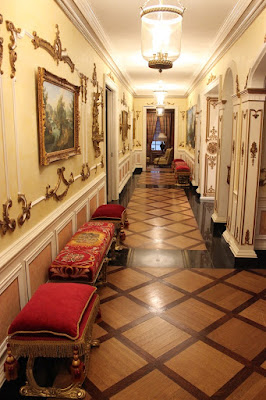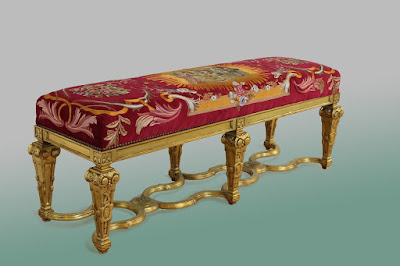Time flies and somehow more than five months have passed us by; it is time for the next-to-last installation of the Furniture of the Utrecht Psalter. We have now reached the letters 'S' and 'T' which are for stand and table. We have already looked at round tables, but this time we will be discussing those with rectangular forms.
 |
A servant returns a wine jug to a round stand next the dining table
after serving the guests in this scene from the Utrecht Psalter |
 |
This illustration is so abstract that it is
almost impossible to say what is on
the pedestal, but sculpture and artwork
would often be placed on such objects |
Examples of pedestals and stands abound in medieval manuscripts and other artwork, but these mostly serve as candle or ink stands in scenes depicting the Four Evangelists. Unfortunately, like most forms of furniture from the first seven centuries of the Middle Ages, there are no surviving examples; the Utrecht, and Stuttgart Psalters, especially, inform us that there were many forms and uses for stands other than in the scriptorium. We see that, in addition to holding candles and ink, they could be used as a sideboard or serving stand, as a pedestal for a sculpture, (as they still are) and as a base to support artwork.
 |
Essentially a stand, this "Pricina Pillar" serves
as a bowl for the holy water in a church |
The forms and ornamentation for these usually followed after contemporary columns of the period and so we can draw some idea for design of them from looking at the holy water fonts in churches, such as this one from St Mary's Chapel, Marlston, a small hamlet some 40km west of where I used to live in Berkshire. It is made of stone, as are all of the others that one will find, still extant. It is probable that many such stone pedestals would have been found in the great houses, castles and palaces as well. It would also stand to reason, however, that wooden examples also existed, and would have been carved or decorated the same as the more permanent stone examples.
Bellow are some other examples from various artworks which demonstrate various forms and uses for pedestals and stands
 |
From an 11th century book cover, in the MET, this stand
serves as a lectern |
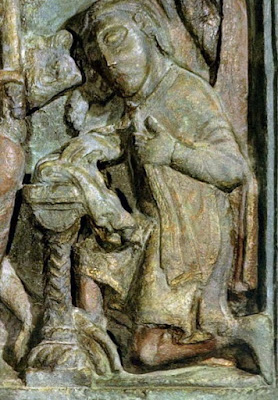 |
A relief sculpture in Maastrich Cathedral, this shows
a servant tending the king; his towel is on a pedestal |
 |
From a 10th century ivory book cover
from Metz, this pedestal holds two
seated figures |
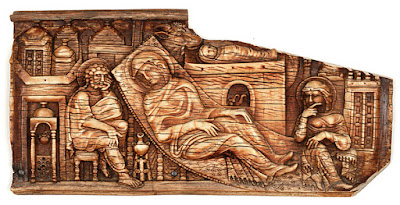 |
From Dumbarton Oaks, this 11th century Italian ivory plaque shows a jug
supported on a tripod stand. Such a stand would clearly have been made
of wood. I saw a small example of this design, used to hold a glass, in the
Louvre, when I visited last year |
 |
Due to the somewhat loose execution of many medieval artworks, it is sometimes
difficult to discern if an object was intended to represent a stand with a level top,
or a sloped surface, as one finds on a lectern. In the case with this sculpture,
however, there can be no ambiguity of the artists intention; he depicted both.
This is part of a beautiful late 12th century tympanum on the cloister church
of St Benoit Sur Loire, (Flurey) in France. |
There are 13 of these pedestals or stands depicted in the Utrecht manuscript, each of them different from the others, but none of them, as with all of the other furniture illustrated, has any particularly well defined details.
Similarly, there are also seven tables, shown to have a rectangular form, (but usually not having much more detail than that.) All of them have legs on each of the table's four corners; two of them have the addition of a lower stretcher rail in the manner we are familiar with from tables of the 16th and 17th centuries.
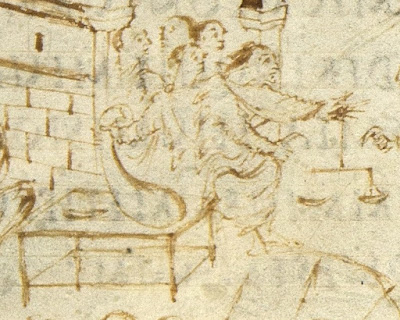 |
| A rectangular table with a lower stretcher connecting the four legs |
 |
Another table, a thousand years newer, (but which most people would consider
very old) showing the same basic design |
 |
This mosaic from Ravena shows, again, the same basic table design; this
one was three hundred years old at the time of the Utrecht Psalter.
It seems that this table design had staying power. |
There are several factors which make it very difficult to trace the stylistic trends of tables over the course of the Middle Ages. First, as already stated, there are no examples of any table before the 12th century, and very few from before the 16th. Artists used what they wished, to portray the message they intended to convey,but this is not always the same as depicting stylistic development and trends. One medieval trend, in fact, was to depict tables with no legs at all. This puts an huge gap in what could be a more informed segment of design history, but because from at least the 9th century, into the 13th, most tables are depicted as a flat or moulded plane with an elaborately draped table cloth, which seems to float in space having no legs at all, we are left to ponder what sorts of supports these tables had.
 |
An ivory fragment from an 11th century box, which shows the typical trend
of portraying a table with no legs. This table does seem to show a moulded
frame around the perimeter. (from the Archaeological Museum, Madrid) |
Much is made of the so-called trestle table, and the table set upon donkeys or horses (depending on where your English comes from), which are supposed to have been so common in the medieval period. From the artwork, there is nothing to support the idea that these were the most prolific forms of tables. In fact, the earliest depiction I have found, to date, clearly showing such a medieval table comes from the 13th century. However, there is a Roman sculpture which shows such a table, so, like many other pre-medieval inventions, they must have continued on, un-portrayed in the artwork, all through the "dark ages", until they reemerged at the end, at which time there was a more prolific campaign of illustrating ordinary objects, and we again find them depicted. In other words, just because no one illustrated one, or more precisely, no illustration of one survives, we cannot say that they did not exist. There are dozens of tools (jeweler's tools, and vices for example) and objects which we have no illustrations of, but deductive reasoning tells us that they were there.
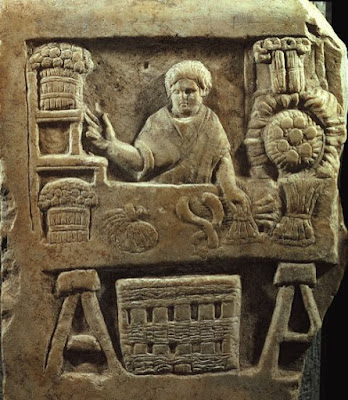 |
3rd century Roman depiction of a flower and vegetable vendor
His table is the familiar "A-frame" table of the late Middle Ages... |
 |
| ...Very much like this table, but without the Gothic ornament. |
There is no such table portrayed in the Utrecht Psalter; the other rectangular tables (four of them) simply have four posts at the corners, and one more has cross stretchers at the ends, but no lateral braces.
 |
| A table with end stretchers but none running length-wise |
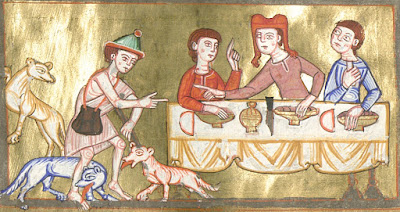 |
A rare example of a table actually depicted with its legs. This one from the
middle of the 12th century and found in BSB Clm 2929 |
It is a shame that almost no early medieval furniture still exists, and therefore we have no real idea of what a 9th, 10th, or 12th century table would have actually looked like. We can, by studying the artwork however, at least see that our pre-conceived ideas are generally flawed. (I read a "history of medieval furniture" which stated that "early" [in that authors vocabulary, meaning pre-14th century] days, tables were simply "rough planks placed upon tree-trunks".) Even if the manuscripts present no life-like depiction of a table, we may still be able to realise that there were many forms and styles of tables, just as there are now. When we combine that with the knowledge that all objects were decorated and ornamented according to the the station of the person possessing them, and followed stylistic trends, we can begin to gain some insight into the potential appearance of medieval tables as they may have been.







